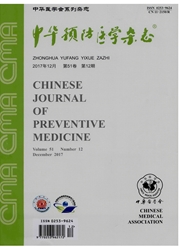

 中文摘要:
中文摘要:
目的 筛选细胞体外恶性转化过程中差异甲基化基因,为毒作用效应以及肿瘤化学预防、生物监测寻找潜在的表观遗传生物标志物.方法 利用苯并[a]芘[B(a)P]诱导水生化人支气管上皮细胞(HBER)转化模型和猿猴空泡病毒小T抗原(SV40 ST)诱导HBER转化模型,采用甲基化DNA免疫沉淀-全基因组扩增法富集基因组甲基化DNA,应用甲基化芯片技术和信息学分析方法,寻找不同作用因素诱导细胞转化的共同差异甲基化基因,通过RT-PCR法检测这些基因在B(a)P诱导HBER细胞转化过程中mRNA表达水平的变化.结果 芯片检测发现,HBER、染毒后末转化细胞株(HBERNT)和转化细胞株(HBERT)中甲基化基因的数目分别为733、661、738个,83个基因在染毒前呈非甲基化状态,而在转化前和转化后呈甲基化状态,在这83个基因中,有25个基因在SV40ST诱导HBER转化细胞株(HBERST)中同样发生高甲基化.其中,序列相似性家族178A(family with sequence similarity 178,member A,FAM178A)、视黄酸受体应答子(他扎罗汀诱导)[retinoic acid receptor responder(tazarotene induced),RARRES1]、泛素特异性肽酶28(ubiquitin specific peptidase 28,USP28)、Scm-like with four mbt domains 2(SFMBT2)、序列相似性家族59A(family with sequence similarity 59,member A,FAM59A)和核受体亚家族4组A3(nuclear receptor subfamily 4,group A,member 3,NR4A3)等6个基因在B(a)P诱导HBER细胞转化过程中mRNA表达水平下降.结论 细胞体外转化过程中筛查出来的特定基因高甲基化,可能成为化学毒物暴露监测及肿瘤预测的生物标志物.
 英文摘要:
英文摘要:
Objective To explore potential epigenetic biomarkers for toxic effects, tumor-related chemical prevention and biological monitor by a genome-wide screening for differential DNA methylation during human cell malignant transformation in vitro. Methods The two in vitro cell transformation models included B( a)P-induced human bronchial epithelial cell introduced by H-Ras (HBER) cell transformation and simian vacuolating virus 40 small T antigen induced (SV40 ST-induced ) HBER cell transformation. Methylated genes were collected by methylated DNA immunoprecipitation and whole genome amplification (MeDIP-WGA) at three time points during cell transformation which represented different transformation stage. Then, CpG island microarray was used to screen differentially methylated genes. The mRN A levels of hypermethylated genes were also observed by RT-PCR. Results The CpG island microarray showed that the number of hypermethylated genes in HBER,HBERNT,HBERT cells were 733,661 and 738 respectively. 83 genes were hypermethylated in pre-transformed cell and transformed cell. Moreover, 25 of 83 genes were also hypermethylated in SV40 ST-transformed cell (HBERST). We further confirmed that the mRNA expression of six of these 25 genes, namely family with sequence similarity 178, member A ( FAM178A ), retinoic acid receptor responder ( tazarotene induced ) ( RARRES1 ), ubiquitin specific peptidase 28 (USP28) ,Scm-like with four mbt domains 2 (SFMBT2), family with sequence similarity 59,member A(FAM59A) and nuclear receptor subfamily 4 ,group A,member 3 (NR4A3) were supressed during B(a) P-induced transformation. Conclusion The abnormal hypermethylation of specific genes was a common event in the two kinds of human cell transformation models, which shed light on the study for chemical exposure monitor and tumor-related epigenetic biomarkers.
 关于邢秀梅:
关于邢秀梅:
 关于张波:
关于张波:
 关于李道传:
关于李道传:
 关于王庆:
关于王庆:
 关于陈丽萍:
关于陈丽萍:
 关于肖勇梅:
关于肖勇梅:
 同期刊论文项目
同期刊论文项目
 同项目期刊论文
同项目期刊论文
 CpG Site-Specific Hypermethylation of p16INK4 alpha in Peripheral Blood Lymphocytes of PAH-Exposed W
CpG Site-Specific Hypermethylation of p16INK4 alpha in Peripheral Blood Lymphocytes of PAH-Exposed W DNA repair gene deficiency does not predispose human bronchial epithelial cells to benzo(a)pyrene-in
DNA repair gene deficiency does not predispose human bronchial epithelial cells to benzo(a)pyrene-in Global and MGMT promoter hypomethylation independently associated with genomic instability of lympho
Global and MGMT promoter hypomethylation independently associated with genomic instability of lympho Genetic damage induced by organic extract of coke oven emissions on human bronchial epithelial cells
Genetic damage induced by organic extract of coke oven emissions on human bronchial epithelial cells A Novel GSK-3 beta-C/EBP alpha-miR-122-Insulin-Like Growth Factor 1 Receptor Regulatory Circuitry in
A Novel GSK-3 beta-C/EBP alpha-miR-122-Insulin-Like Growth Factor 1 Receptor Regulatory Circuitry in Identification and Functional Analysis of Variant Haplotypes in the 5 '-Flanking Region of Protein P
Identification and Functional Analysis of Variant Haplotypes in the 5 '-Flanking Region of Protein P Loss of PPP2R2A ?Inhibits Homologous Recombination DNA Repair and Predicts Tumor Sensitivity to PARP
Loss of PPP2R2A ?Inhibits Homologous Recombination DNA Repair and Predicts Tumor Sensitivity to PARP Aberrant Promoter Methylation of p16 In Peripheral Blood Lymphocytes of Coke-oven Workers and Benzo(
Aberrant Promoter Methylation of p16 In Peripheral Blood Lymphocytes of Coke-oven Workers and Benzo( Upregulation of miR-27a Contributes to the Malignant Transformation of Human Bronchial Epithelial Ce
Upregulation of miR-27a Contributes to the Malignant Transformation of Human Bronchial Epithelial Ce Global and MGMT promoter hypomethylation independently associated with genomicinstability of lymphoc
Global and MGMT promoter hypomethylation independently associated with genomicinstability of lymphoc 期刊信息
期刊信息
